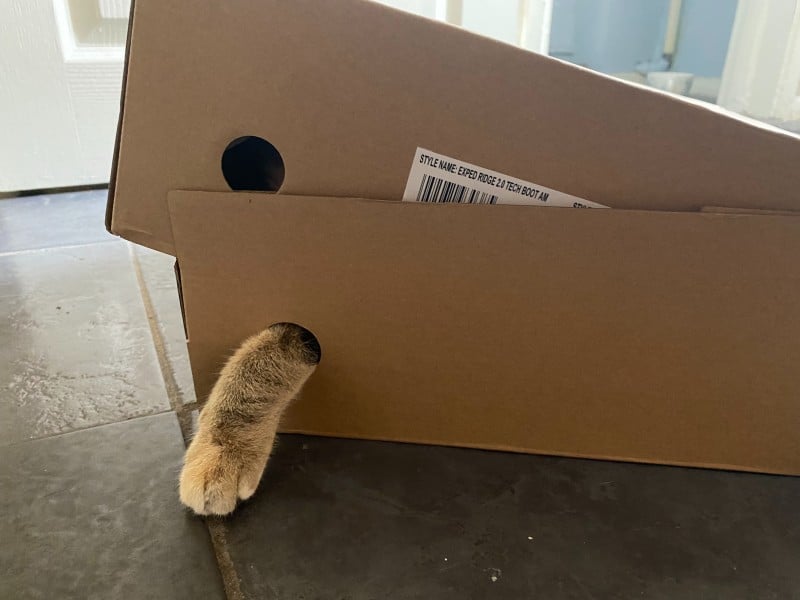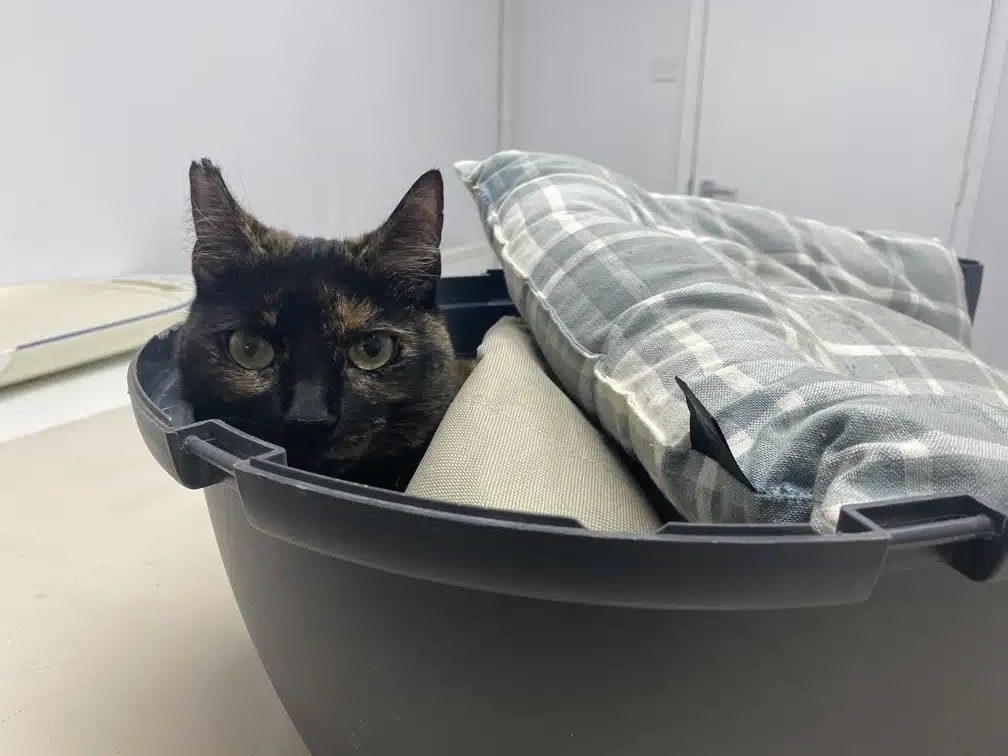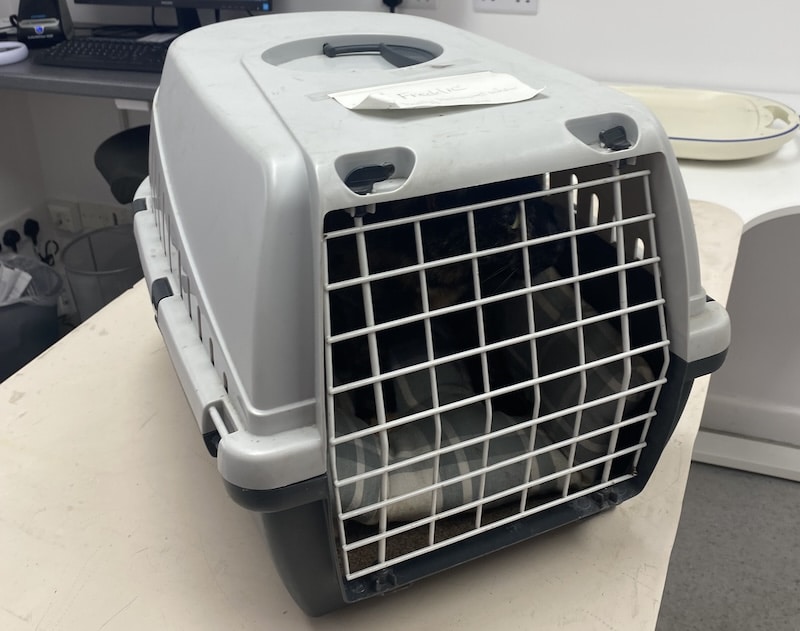Hi, I’m Dr. Lauren! Read my introduction to learn more about me and my two adventurous cats, Pancake and Tiller.
OK, I’m just going to say it. Size matters.
When it comes to cat carriers, that is.
Cat carriers are the bane of many cat owners’ existence…and one of the most common reasons people miss their vet appointments (“I couldn’t get her into the carrier! She scratched me and then ran off”). I’ve literally had people chase their cat around the house for hours before an appointment, and I promise, no one is benefiting from that situation!
Imagine for a moment: you’re having your morning coffee, maybe your bran flakes…and whoosh! Someone runs into the kitchen, throws you into a giant box, tumbles you around, takes you into something that smells terrible and makes lots of loud noise and you can’t stand up because it’s constantly moving and you feel sick, you hear strange people talking, dogs barking…and suddenly you’re dumped out of this box, and standing in wait are your gynecologist, your internist, your cardiologist, your dentist, your urologist, your gastroenterologist, your proctologist, your podiatrist, your dermatologist… and you’re at their mercy. You might be a tad grumpy to have had your coffee ritual interrupted, too.
Remember, it’s not all that different for a cat. It may make a strong point, but it’s not dissimilar.

What Can You Do About It?
Glad you asked!
There are a number of general rules of thumb when it comes to cat carriers. And remember, these are simply rules of thumb. If a carrier is to a cat as a car is to a human: remember that all humans don’t like the same style of car. Neither should cats.
Rules of Thumb For Cat Carriers
- Most cats prefer a size big enough for them to stand, turn around easily, and sit comfortably upright
- It should be hard-sided, or able to maintain its shape (e.g. not collapse) when the door is opened
- Speaking of doors, at least 2 entry/exit points. So a door and the top easily comes off, or a door and the top unzips, or a front and top door
- At least one, ideally both, entry points need to be larger than your cat. This prevents shoulders and feet from easily getting stuck, and therefore getting cats in and out of carriers from becoming a nightmare
- Beds that are carriers (the convertibles of the cat carrier world!) are improving exponentially- and many cats really like them. Some are even crash-tested, as the one linked here.
- Bubble backpacks get a lot of flack, of late. On one hand, they are trendy…but behaviorists think cats hate them. I’ve yet to get a cat to give me a definitive answer, but I’ve seen feline practice in big European cities… where most people walk their cats to appointments from their homes, anywhere from a few blocks to many blocks. In instances like that, the cat is up high, they are a bit more soundproof, the cat has some visibility but can still hide… Not saying these carriers are perfect, but they are probably better than a traditional carrier at dog level, with lots of noise and smells wafting right in.
- Dog crates can be good for big breeds like Maine Coons and Bengals. Though, you may want to add wheels. I’ve even seen them come in on red flyer wagons before!
- When all else fails: pillowcases make a great emergency carrier for a cat!
Using the Carrier
One of the trickiest parts about a carrier is its usage. Such a simple thing, that can become so complicated when you add one single ingredient: the cat.
I’ll be honest, rarely does putting your cat headfirst into a carrier work. They are masters at wriggling out. If you do go this route, do it confidently, and don’t hesitate. You generally get one chance to get it right.
I prefer the tip method:
- Tip the carrier on its end, and have someone hold it for stability.
- Cup your cat’s butt, and slide them butt first into the carrier.
- Generally, this is done before your cat knows what is happening, and far less stress than trying to stuff an unwilling cat headfirst into the carrier.
- When it doesn’t work, the most common reason is that the door of the carrier is too narrow: their butt and shoulders almost touch the sides, so it’s easy for these to become stuck as you are trying to place the cat inside.

Final Thoughts On Cat Carriers
Teach cats at a young age to see the carrier as a commonplace item. Allow them treats in the carrier, and leave it out for them to sleep in on a regular basis- even if you simply take off the front door to allow easy access. Don’t simply get it out the day you want to use it!
Keep the carrier clean, when not in use. Cats can vomit, urinate, defecate, and shed inside the carrier during travel- clean it out after use. Would you want to be shoved into a car with months’ old dirt, and expect that to be a fun journey? Pheromone sprays and wipes can also be used to further reduce travel stress. Put some treats, and a favorite toy or blanket, in, as well.
Treat carriers a bit like your car, because, essentially, to a cat, that’s what they are. If they are broken, fix them. Keep them clean, tidy, and ready for daily use. Sometimes, the new fancy ones have some bells and whistles that work really well, and look very stylish. And sometimes, the old-fashioned ones do it best. Regardless, a carrier is essential for cat ownership—just go with what works for you, and your cat.






